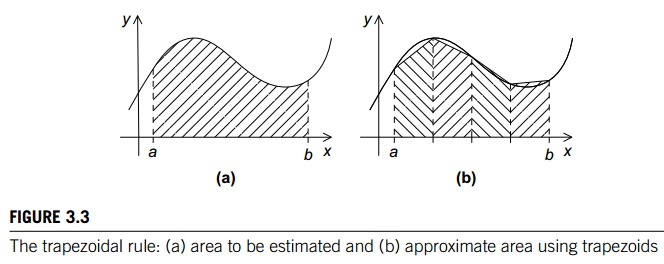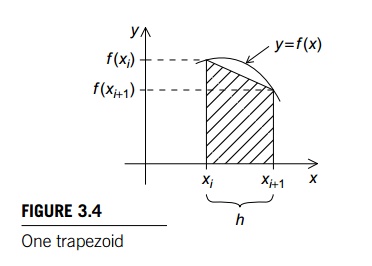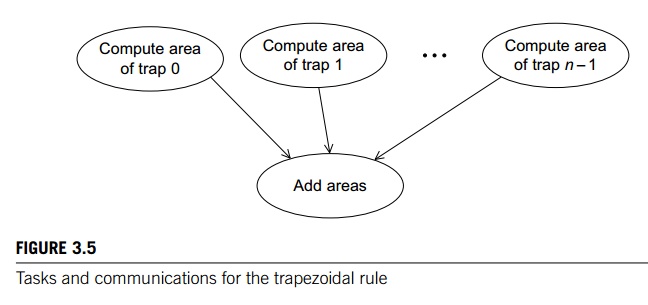Chapter: An Introduction to Parallel Programming : Distributed-Memory Programming with MPI
The Trapezoidal Rule in MPI
THE TRAPEZOIDAL RULE IN MPI
Printing messages from
processes is all well and good, but we’re probably not tak-ing the trouble to
learn to write MPI programs just to print messages. Let’s take a look at a
somewhat more useful program—let’s write a program that implements the
trapezoidal rule for numerical integration.
1. The trapezoidal rule
Recall that we can use the trapezoidal rule to
approximate the area between the graph of a function, y = f(x), two vertical lines, and the x-axis. See Figure 3.3. The basic idea is to
divide the interval on the x-axis into n equal subintervals. Then we approxi-mate the area lying between
the graph and each subinterval by a trapezoid whose base is the subinterval,
whose vertical sides are the vertical lines through the endpoints of the
subinterval, and whose fourth side is the secant line joining the points where
the vertical lines cross the graph. See Figure 3.4. If the endpoints of the
subinterval are xi and xi+1, then the length of the subinterval is h =
xi+1- xi. Also, if the lengths of the two vertical segments are f(xi) and f (xi+1), then the area of the trapezoid is


Since we chose the n subintervals so that they would all have the same length, we also
know that if the vertical lines bounding the region are x = a and x = b, then

Thus, if we call the leftmost endpoint x0, and the rightmost endpoint xn, we have
x0 = a, x1 = a + h, x2 = a + 2h, …., xn -1 = a + (n-1)h, xn = b,
and the sum of the areas of the trapezoids—our
approximation to the total area—is
Sum of trapezoid areas = h[ f (x0)/2 + f (x1) + f (x2) + + f (xn-1)+ f (xn)/2].
Thus, pseudo-code for a serial program might
look something like this:
/* Input: a, b, n */
h = (b-a)/n;
approx = (f(a) + f(b))/2.0;
for (i = 1; i <= n-1; i++) {
x_i = a + i* h;
approx
+= f(x_i);
}
approx = h*approx;

2. Parallelizing the trapezoidal rule
It is not the most attractive word, but, as we
noted in Chapter 1, people who write parallel programs do use the verb
“parallelize” to describe the process of converting a serial program or
algorithm into a parallel program.
Recall that we can design a parallel program
using four basic steps:
Partition
the problem solution into tasks.
Identify
the communication channels between the tasks.
Aggregate
the tasks into composite tasks.
Map the
composite tasks to cores.
In the partitioning phase, we usually try to
identify as many tasks as possible. For the trapezoidal rule, we might identify
two types of tasks: one type is finding the area of a single trapezoid, and the
other is computing the sum of these areas. Then the communication channels will
join each of the tasks of the first type to the single task of the second type.
See Figure 3.5.
So how can we aggregate the tasks and map them
to the cores? Our intuition tells us that the more trapezoids we use, the more
accurate our estimate will be. That is, we should use many trapezoids, and we
will use many more trapezoids than cores. Thus, we need to aggregate the
computation of the areas of the trapezoids into groups. A natural way to do
this is to split the interval [a, b] up into comm sz subintervals. If comm sz evenly divides n, the number of trapezoids,
we can simply apply the trape-zoidal rule with n=comm sz trapezoids to each of the comm sz subintervals. To finish, we can have one of the processes, say
process 0, add the estimates.
Let’s make the simplifying assumption that comm sz evenly divides n. Then pseudo-code for the program might look something like the
following:
1 Get
a, b, n;
2 h
= (b a)/n;
3 local_n
= n/comm sz;
4 local_a = a
+ my rank*local_n*h;
5 local_b = local_a
+ local_n*h;
6 Local_integral
= Trap(local_a, local_b, local_n, h);

7 if
(my_rank != 0)
8 Send
local_integral to process 0;
9 else
/* my rank == 0 */
10 total_integral
= local_integral;
11 for
(proc = 1; proc < comm._sz; proc++) {
Receive
local_integral from proc;
total_integral
+= local_integral;
}
}
if
(my_rank == 0)
print
result;
Let’s defer, for the moment, the issue of input
and just “hardwire” the values for a, b, and n. When we do this, we get the MPI program shown in Program 3.2. The Trap function is just an implementation of the
serial trapezoidal rule. See Program 3.3.
Notice that in our choice of identifiers, we
try to differentiate between local and global variables. Local variables are variables whose contents are significant only on the process that’s using them. Some examples
from the trapezoidal rule program are local_a, local_b, and local_n. Variables whose contents are significant to
all the processes are sometimes called global variables. Some examples from the trapezoidal rule are a, b, and n. Note that this usage is different from the
usage you learned in your introductory programming class, where local variables
are private to a single function and global variables are accessible to all the
functions. However, no confusion should arise, since the context will usually
make the meaning clear.
Related Topics